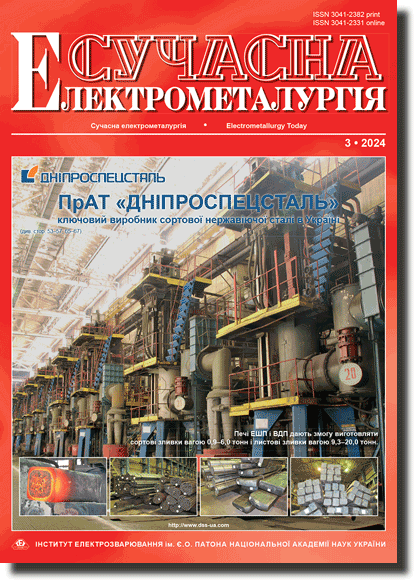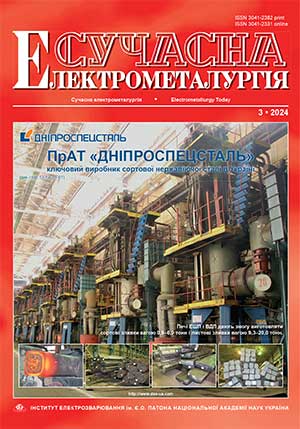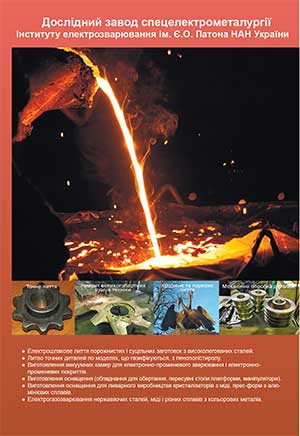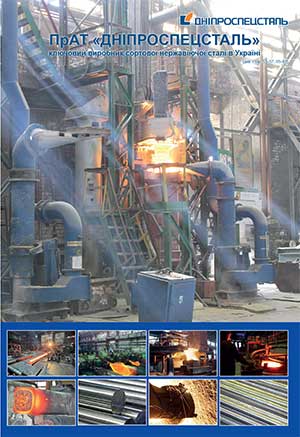| 2024 №03 (09) |
DOI of Article 10.37434/sem2024.03.01 |
2024 №03 (02) |
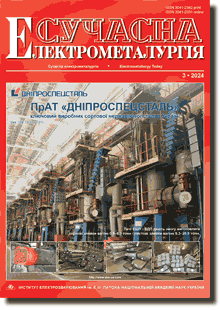
"Suchasna Elektrometallurgiya" (Electrometallurgy Today), 2024, #3, 3-12 pages
Influence of high damping coatings on the resonant vibrations of a titanium plate
O.S. Kremenchutskyi, A.I. Ustinov
E.O. Paton Electric Welding Institute of the NAS of Ukraine 11 Kazymyr Malevych Str., 03150, Kyiv, Ukraine. E-mail: kremens44@gmail.comAbstract
The results of a study of the influence of high damping Co‒Ni and Co‒Fe coatings on the resonant vibrations of the titanium plate-coating system are presented. It has been established that when the amplitude of the resonant vibrations of the system increases to a certain critical value, the dependence of the characteristics of its resonant vibrations on the parameters of external excitation becomes nonlinear. The value of the critical vibrations amplitude, at which a transition from weakly linear to nonlinear vibrations is observed, depends on the slope of the amplitude dependence of the damping capacity (DC) of the system: the steeper the amplitude dependence of the DC, the lower the critical amplitude value, at which the system transition to nonlinear vibrations occurs. Nonlinearity of vibrations manifests itself both in an abrupt change in amplitude with a slight change in the frequency of forced vibrations, and in the occurrence of hysteresis in the amplitude-frequency dependences. The transition of a system to vibrations mode with strong nonlinearity can affect the efficiency of suppression of resonant vibrations with large amplitude in it. 19 Ref., 2 Tabl., 10 Fig.
Keywords: damping coating, resonant vibration, amplitude-frequency dependence, damping capacity, logarithmic decrement
Received: 05.03.2024
Received in revised form: 17.06.2024
Accepted: 06.09.2024
References
1. Matveev, V.V. (1985) Vibration damping of deformed bodies. Kyiv, Naukova Dumka [in Russian].2. Yakovlev, A.P. (1985) Dissipation properties of nonhomogeneous materials and systems. Kyiv, Naukova Dumka [in Russian].
3. Torvik, J., Langley, B. (2015) Material properties of hard coatings developed for high damping. In: Proc. of 51st AIAA/SAE/ ASEE Joint Propulsion Conf., Orlando, Florida, USA, July 29, 2015, 4195. https://doi.org/10.2514/6.2015-4195
4. Yen, H.-Y., Herman Shen, M.-H. (2001) Passive vibration suppression of beams and blades using magnetomechanical coating. J. of Sound and Vibration, 245(4), 701-714. https://doi.org/10.1006/jsvi.2001.3561
5. Ustinov, A.I., Movchan, B.A., Lemke, F., Skorodzievskii, V.S. (2001) Damping capacity of Co-Ni and Co-Fe coatings produced by electron-beam deposition. Vibr. Tekh. Tekhnol., 20(4), 123-126 [in Russian].
6. Skorodzievskii, V.S., Ustinov, A.I., Polishchuk, S.S. et al. (2019) Dissipative properties of Al-(Fe, Cr) vacuum coatings with different composite structures. Surf. & Coat. Technol., 367, 179-186. https://doi.org/10.1016/j.surfcoat.2019.03.074
7. Movchan, B.A., Ustinov, A.I. (2005) Highly damping hard coatings for protection of titanium blades. In: Proc. of RTO AVT-121 Symp. on Evaluation, Control and Prevention of High Cycle Fatigue in Gas Turbine Engines for Land, Sea and Air Vehicles, Seville, Spain, October 3-5, 2005, 11.
8. Tassini, N., Lambrinou, K., Mircea, I. et al. (2007) Study of the amplitude-dependent mechanical behavior of yttria-stabilized zirconia thermal barrier coatings. J. Eur. Ceram. Soc., 27, 1487-1491. https://doi.org/10.1016/j.jeurceramsoc.2006.05.041
9. Ustinov, A.I., Taranenko, V.M., Telychko, V.O. et al. (2011) Effect of nanocomposite coating on the damping capacity of titanium working blades of AGTE. Vibr. Tekh. Tekhnol., 63(3), 74-78 [in Russian].
10. Stoker, J.J. (1950) Nonlinear vibrations in mechanical and electrical systems. New York, Intersci. Publ. Inc.
11. Jacobsen, L.S. (1930) Steady forced vibrations as influenced by damping. Transact. ASME, 52, 169-178. https://doi.org/10.1115/1.4057368
12. Heitz, T., Richard, B., Giry, C., Ragueneau, F. (2017) Damping capabilities of reinforced concrete components in the beyond design range from the identification to a critical review of common best-practices. In: Proc. of 24th Conf. on Structural Mechanics in Reactor Technology BEXCO, Busan, Korea, August 20-25, 2017. https://hal.archives-ouvertes.fr/hal-02418149
13. Cochardt, A.W. (1953) The origin of damping in high-strength ferromagnetic alloys. J. Appl. Mech., 20(2), 196-200. https://doi.org/10.1115/1.4010649
14. Ustinov, A.I., Nekrasov, A.A., Perederiy, V.A. et al. (2012) Device for dissipative properties research of metallic flat samples and coatings. Zavod. Laboratoriya, 10, 41-44 [in Russian].
15. Favstov, Yu.K., Shulga, Yu.N., Rakhshtadt, A.G. (1980) Metals Sci. of High-Damping Alloys. Moscow, Metallurgiya [in Russian].
16. Udovenko, V.A., Chudakov, I.B., Polyakova, N.A. (1993) The fine crystalline and magnetic structure of high-damping alloys based on the Fe-Cr system. Fiz. Met. Metalloved., 75(3), 48-55 [in Russian].
17. Udovenko, V.A., Tishaev, S.I., Chudakov, I.B. (1993) Magnetic domain structure and damping in alloys of the Fe-Al system. Physics Doclady, 38(4), 168-170 [in Russian].
18. Karimi, A., Azcoitia, Ch., Degauque, J. (2000) Relationships between magnetomechanical damping and magnetic properties of Fe-Cr(Al, Mo) alloys. J. of Magnetism and Magnetic Materials, 215-216, 601-603. https://doi.org/10.1016/S0304-8853(00)00235-3
19. Herman Shen, M.-H. (2008) Free layer blade damper by magneto-mechanical materials. United States. Pat. WO 2008/127375 A1.
Advertising in this issue:
To order the electronic version of the paper:
O.S. Kremenchutskyi, A.I. UstinovInfluence of high damping coatings on the resonant vibrations of a titanium plate
Electrometallurgy Today №03 2024 p.3-12
The cost of article (pdf): 13 $, 12 €, 150 UAH (1 copy. )
fill in the form below:
The cost of subscription/purchase order journals or individual articles
| Journal/Currency | Annual Set | 1 issue printed |
1 issue |
one article |
| TPWJ/USD | 384 $ | 32 $ | 26 $ | 13 $ |
| TPWJ/EUR | 348 € | 29 € | 24 € | 12 € |
| TPWJ/UAH | 7200 UAH | 600 UAH | 600 UAH | 280 UAH |
| AS/UAH | 1800 UAH | 300 UAH | 300 UAH | 150 UAH |
| AS/USD | 192 $ | 32 $ | 26 $ | 13 $ |
| AS/EUR | 180 € | 30 € | 25 € | 12 € |
| SEM/UAH | 1200 UAH | 300 UAH | 300 UAH | 150 UAH |
| SEM/USD | 128 $ | 32 $ | 26 $ | 13 $ |
| SEM/EUR | 120 € | 30 € | 25 € | 12 € |
| TDNK/UAH | 1200 UAH | 300 UAH | 300 UAH | 150 UAH |
| TDNK/USD | 128 $ | 32 $ | 26 $ | 13 $ |
| TDNK/EUR | 120 € | 30 € | 25 € | 15 € |
AS = «Automatic Welding» - 6 issues per year;
TPWJ = «PATON WELDING JOURNAL» - 12 issues per year;
SEM = «Electrometallurgy Today» - 4 issues per year;
TDNK = «Technical Diagnostics and Non-Destructive Testing» - 4 issues per year.





